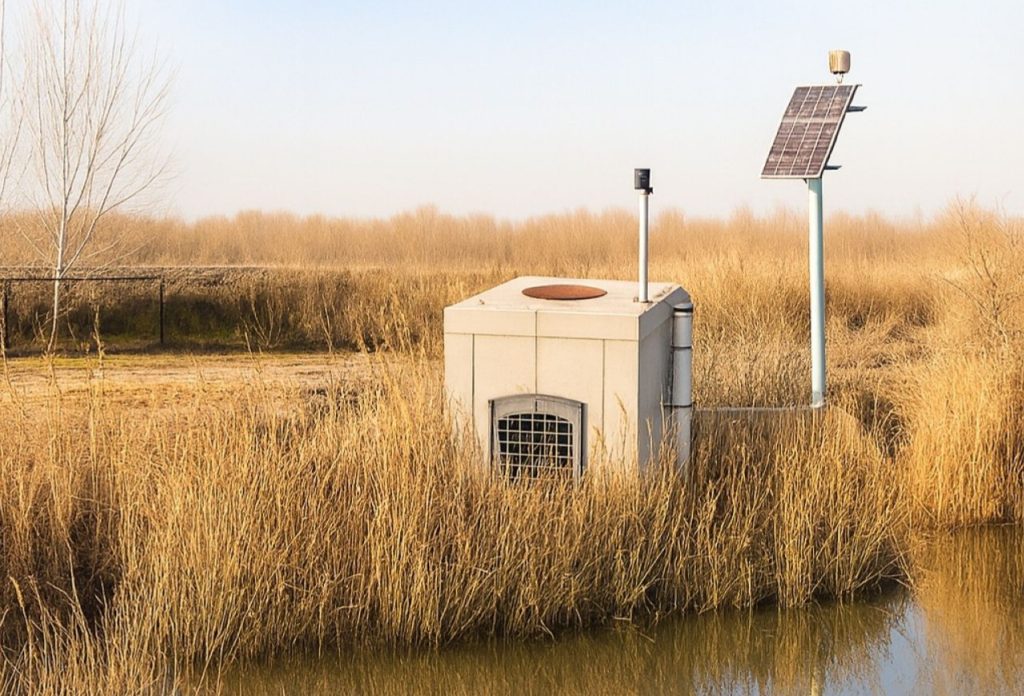Every well-designed pond depends on an efficient pond outlet structure. Acting as the heart of a stormwater management system, outlet structures regulate stormwater flow, control erosion, and protect downstream areas during heavy rain events. For engineers, contractors, and project managers, understanding how to build, maintain, and remediate these control structures is key to achieving long term performance.
What Is a Pond Outlet Structure?
A pond outlet structure is part of a larger drainage system designed to regulate the flow rate of water leaving a pond. Unlike inlets, which capture stormwater runoff, outlet structures direct flow downstream in a controlled manner. They often connect to storm drains, detention tanks, retention tanks, or a box culvert, depending on the site.
These systems are particularly important in urban settings like parking lots, where large amounts of runoff must be managed to prevent flooding. Outlet structures also reduce sediment discharge, enhance erosion control, and maintain water quality.
Parts of a Pond Outlet Structure
A typical outlet control structure consists of several components working together:
- Outlet Pipe: Often made from corrugated metal pipe, metal pipe, or reinforced concrete, this carries water from the pond to downstream systems. Modern designs may also use plastic pipe with a plastic pipe connector or Fernco coupling to transition between materials.
- Trash Racks: A trash rack for ponds or trash rack for pipe is installed at the pipe entrance to prevent large debris from entering. These trash racks are essential to ensure consistent flow and reduce blockages.
- Control Orifices and Weirs: These regulate the flow rate, especially during storm events and high flow conditions.
- Inlet Protection: Upstream controls such as curb inlet protection, drop inlet protection, inlet protection bags, and catch basin inserts keep sediment out before it reaches the outlet.
- Catch Basin Filter Insert: Installed in basins to trap fine sediment and pollutants, ensuring cleaner stormwater flow.
- Detention or Retention Tanks: Systems may connect to a precast concrete detention tank or retention tank, storing water for delayed release or infiltration.
How Pond Outlet Structures Are Built
Building an outlet structure is a site specific process, but there are common sequences:
- Excavation and Foundation: The pond berm is excavated, and a stable base is prepared for the outlet pipe. Reinforced concrete is often poured to secure foundations.
- Pipe Installation: The outlet pipe is laid, using corrugated metal, drain pipe, or concrete depending on design. Connections are made with a pipe plastic connector or Fernco coupling for flexibility.
- Control Structures: Weirs, orifices, and risers are installed to regulate stormwater flow and flow rates.
- Trash Rack Installation: A trash rack for ponds is mounted to the riser or pipe to protect the system from clogging.
- Upstream Protection: Additional measures like curb inlet protection or silt socks are added to filter incoming runoff.
- Finishing and Backfill: The structure is backfilled, compacted, and integrated into the pond berm.
The sequence ensures the outlet can handle both normal flows and extreme storm events.
Common Mistakes in Outlet Structures
Project managers must remain alert to faulty practices that can undermine a pond outlet:
- Incorrect Pipe Material: Using metal pipe without accounting for corrugated metal corrosion leads to early failure.
- Improper Trash Racks: An undersized or missing trash rack for pipe allows debris to clog the outlet pipe during storm events.
- Poor Flow Control: If control structures aren’t sized to site specific conditions, high flow overwhelms the system.
- Skipping Inlet Protection: Without inlet protection bags or catch basin inserts, sediment reaches the outlet and reduces storage capacity.
- Weak Joints: Failing to use connectors like Fernco couplings or a secure plastic pipe connector causes leaks.
Remediation and Repairs
When outlet components fail, remediation must be swift to protect downstream systems:
- Pipe Rehabilitation: Damaged corrugated metal pipe may be replaced with reinforced concrete or HDPE. A Fernco coupling allows new sections to be connected without replacing the entire line.
- Trash Rack Replacement: If a rack corrodes or bends, a stronger design prevents recurring blockages.
- Filter Upgrades: Installing or replacing catch basin filter inserts improves sediment capture.
- Tank Adjustments: A precast concrete detention tank can be retrofitted with improved orifices to adjust release timing.
- Erosion Control Measures: If stormwater flow causes channel damage, additional erosion control blankets or riprap may be installed downstream.
These steps help extend system performance for the long term.
Why Outlet Structures Matter
Pond outlet structures are more than pipes—they are engineered drainage solutions that balance storage, filtration, and controlled release. When built with proper outlet structures, storm drains, detention tanks, and retention tanks all work together to protect communities from flooding.
For contractors, understanding materials, installation sequences, and maintenance practices ensures every project is resilient during both routine flows and major storm events.
Conclusion
A well-designed pond outlet structure integrates pipes, trash racks, filters, and control structures to handle stormwater runoff efficiently. From detention tanks and retention tanks to catch basin inserts and curb inlet protection, every part has a role in ensuring durability and performance.
When mistakes occur—whether it’s faulty metal pipe, undersized trash racks, or poor flow design—repairs must focus on restoring long term stability with better materials like reinforced concrete and stronger filtration systems.
Prime Contractor Supply delivers the outlet control structures, pipes, fittings, and erosion control solutions contractors need to build reliable systems. With the right tools, every pond outlet can withstand storm events, protect downstream environments, and provide confidence for decades.

